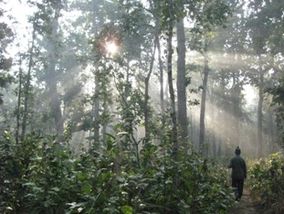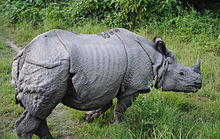Bardiya National Park: Difference between revisions
BhagyaMani (talk | contribs) revised with ref edits |
BhagyaMani (talk | contribs) →Vegetation: extended with ref |
||
| Line 32: | Line 32: | ||
==Vegetation== |
==Vegetation== |
||
About 70% of the park is covered with forest with the balance a mixture of grassland, [[savanna]]h and [[riparian zone|riverine forest]].<ref name="dinerstein1979">Dinerstein, E. (1979) ''An ecological survey of the royal Karnali-Bardia Wildlife Reserve, Nepal. Part I: Vegetation, modifying factors, and successional relationships.'' Biological Conservation 15(2): 127–150 [http://www.sciencedirect.com/science?_ob=ArticleURL&_udi=B6V5X-48XVM63-24&_user=10&_coverDate=02%2F28%2F1979&_rdoc=1&_fmt=high&_orig=search&_sort=d&_docanchor=&view=c&_searchStrId=1269513485&_rerunOrigin=scholar.google&_acct=C000050221&_version=1&_urlVersion=0&_userid=10&md5=8fc83134bb6fc629ef44f5a8b1f961bc Abstract]</ref> |
About 70% of the park is covered with forest, with the balance a mixture of grassland, [[savanna]]h and [[riparian zone|riverine forest]].<ref name="dinerstein1979">Dinerstein, E. (1979) ''An ecological survey of the royal Karnali-Bardia Wildlife Reserve, Nepal. Part I: Vegetation, modifying factors, and successional relationships.'' Biological Conservation 15(2): 127–150 [http://www.sciencedirect.com/science?_ob=ArticleURL&_udi=B6V5X-48XVM63-24&_user=10&_coverDate=02%2F28%2F1979&_rdoc=1&_fmt=high&_orig=search&_sort=d&_docanchor=&view=c&_searchStrId=1269513485&_rerunOrigin=scholar.google&_acct=C000050221&_version=1&_urlVersion=0&_userid=10&md5=8fc83134bb6fc629ef44f5a8b1f961bc Abstract]</ref> |
||
The flora recorded in the park comprises 839 species of flora, including 173 [[vascular plant]] species comprising 140 [[dicot]]s, 26 [[monocot]]s, six [[pteridophytes|fern]], and one [[gymnosperm]] species.<ref name=nbrb07>Bhuju, U.R., Shakya, P.R., Basnet, T.B., Shrestha, S. (2007) [http://books.icimod.org/demo/uploads/ftp/Nepal%20Biodiversity%20Resource%20Book.pdf ''Nepal Biodiversity Resource Book. Protected Areas, Ramsar Sites, and World Heritage Sites'']. International Centre for Integrated Mountain Development, Ministry of Environment, Science and Technology, in cooperation with United Nations Environment Programme, Regional Office for Asia and the Pacific. Kathmandu, ISBN 978-92-9115-033-5</ref> |
|||
== Fauna == |
== Fauna == |
||
Revision as of 16:52, 1 April 2011
| Bardiya National Park | |
|---|---|
 Forest in Bardiya National Park | |
| Lua error in Module:Location_map at line 526: Unable to find the specified location map definition: "Module:Location map/data/LocMap Bardia.png" does not exist. | |
| Location | Nepal |
| Area | 968 km² |
| Established | 1988 |
Bardiya National Park is located in the Far-Western Region, Nepal and was established in 1988 as Royal Bardia National Park. Covering an area of 968 km2 (374 sq mi) it is the largest and most undisturbed wilderness area in the Terai, adjoining the eastern bank of the Karnali River in the Bardiya District.[1]
The northern limits of the protected area are demarcated by the crest of the Siwalik Hills. The Nepalgunj-Surkhet highway partly forms the southern boundary, but seriously disrupts the protected area. Natural boundaries to human settlements are formed in the west by the Geruwa, a branch of the Karnali River, and in the southeast by the Babai River.[1]
Together with the neighboring Banke National Park, the coherent protected area of 1,518 km2 (586 sq mi) represents the Tiger Conservation Unit (TCU) Bardia-Banke.[2][3]
Listen to pronunciation of Bardiya National Park's local name
History
In 1815, Nepal lost this region to the East India Company through the Sugauli Treaty. For 45 years it was a part of British India and returned to Nepal in 1860 in recognition for supporting the suppression of the Indian Independence movement in 1857. Today, this annexed area is still called Naya Muluk meaning new country. An area of 368 km2 (142 sq mi) was set aside as Royal Hunting Reserve in 1969 and gazetted as Royal Karnali Wildlife Reserve in 1976. In 1982, it was proclaimed as Royal Bardia Wildlife Reserve and extended to include the Babai River Valley in 1984. Finally in 1988, the protected area was gazetted as national park.[1]
The approximately 1500 people who used to live in this valley have been resettled elsewhere. Since farming has ceased in the Babai Valley, the natural regenerated vegetation makes the area a prime habitat for wildlife.[1]
Vegetation
About 70% of the park is covered with forest, with the balance a mixture of grassland, savannah and riverine forest.[4] The flora recorded in the park comprises 839 species of flora, including 173 vascular plant species comprising 140 dicots, 26 monocots, six fern, and one gymnosperm species.[5]
Fauna


The park provides excellent habitat for endangered animals like rhinoceros, wild elephant (one of only two known remaining herds), Bengal tiger, swamp deer, black buck, gharial and mugger crocodiles, and Gangetic dolphin. Endangered birds include the Bengal florican, lesser florican, silver-eared mesia and Sarus crane. More than 30 different mammals, over 200 species of birds, and many snakes, lizards and fish have been recorded in the park's forest, grassland and river habitats. A good number of resident and migratory birds are found in the park.
References
- ^ a b c d Majupuria, T.C., Kumar, R. (1998) Wildlife, National Parks and Reserves of Nepal. S. Devi, Saharanpur and Tecpress Books, Bangkok. Isbn 974-89833-5-8
- ^ Wikramanayake, E.D., Dinerstein, E., Robinson, J.G., Karanth, K.U., Rabinowitz, A., Olson, D., Mathew, T., Hedao, P., Connor, M., Hemley, G., Bolze, D. (1999) Where can tigers live in the future? A framework for identifying high-priority areas for the conservation of tigers in the wild. In: Seidensticker, J., Christie, S., Jackson, P. (eds.) Riding the Tiger. Tiger conservation in human-dominated landscapes. Cambridge University Press, Cambridge. hardback isbn 0 521 64057 1, paperback isbn 0 521 64835 1
- ^ Nepalnews (2010) article Govt announces creation of 550 sq km Banke National Park. Nepalnews 13 May 2010
- ^ Dinerstein, E. (1979) An ecological survey of the royal Karnali-Bardia Wildlife Reserve, Nepal. Part I: Vegetation, modifying factors, and successional relationships. Biological Conservation 15(2): 127–150 Abstract
- ^ Bhuju, U.R., Shakya, P.R., Basnet, T.B., Shrestha, S. (2007) Nepal Biodiversity Resource Book. Protected Areas, Ramsar Sites, and World Heritage Sites. International Centre for Integrated Mountain Development, Ministry of Environment, Science and Technology, in cooperation with United Nations Environment Programme, Regional Office for Asia and the Pacific. Kathmandu, ISBN 978-92-9115-033-5
